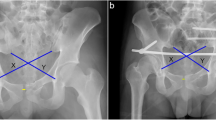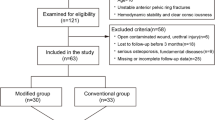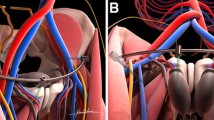Abstract
Purpose
The purpose of this study was to determine the outcome of unstable type C pelvic fractures treated with posterior stabilisation and the anterior subcutaneous internal fixator (ASIF).
Methods
Altogether, 36 consecutive patients were treated for unstable type C pelvic ring fractures using posterior stabilisation and ASIF. After a minimum of 18 months, the clinical and radiological outcome was retrospectively investigated.
Results
Overall, three patients (8.3 %) died, and 31 patients (86 %) were available for follow-up after a mean of 4.5 years. Thirty of 31 patients (97 %) showed radiographic bone consolidation of both the posterior and anterior pelvic ring. Only one non-union and two infections due to the anterior device were observed. The total German pelvic outcome score showed an excellent or good rating for 64.5 % of the patients, and a fair or poor for 35.5 %. The SF-12 questionnaire showed a significantly reduced total score for physical and mental health compared to a general reference population.
Conclusions
The ASIF represents an innovative surgical procedure for the treatment of type C pelvic ring fractures. In the medium term, patient satisfaction was high and the complication rate was low, despite the small number of patients. More cases must be investigated before the procedure can be recommended in general, possibly replacing the external fixator for the treatment of pelvic ring fractures in the future.




Similar content being viewed by others
References
Black EA, Lawson CM, Smith S et al (2011) Open pelvic fractures: The University of Tennessee Medical Center At Knoxville experience over ten years. Iowa Orthop J 31:193–198
Davarinos N, Ellanti P, Morris S et al (2012) Epidemiology of pelvic and acetabular trauma in a Dublin tertiary hospital: a 10-year experience. Ir J Med Sci 181:243–246
Grotz MR, Allami MK, Harwood P et al (2005) Open pelvic fractures: epidemiology, current concepts of management and outcome. Injury 36:1–13
Ganz R, Krushell RJ, Jakob RP et al (1991) The antishock pelvic clamp. Clin Orthop 267:71–78
Nothofer W, Thonke N, Neugebauer R (2004) Treatment for unstable sacral fracture in pelvic ring disruptions with dorsal sacrum distantly anchored ORIF (DSDO). Unfallchirurg 107:118–127
Rysavy M, Pavelka T, Khayarin M et al (2010) Iliosacral screw fixation of the unstable pelvic ring injuries. Acta Chir Orthop Traumatol Cech 77:209–214
Kobbe P, Hockertz I, Sellei RM et al (2012) Minimally invasive stabilisation of posterior pelvic-ring instabilities with a transiliac locked compression plate. Int Orthop 36:159–164
Suzuki T, Hak DJ, Ziran BH et al (2009) Outcome and complications of posterior transiliac plating for vertically unstable sacral fractures. Injury 40:405–409
Dienstknecht T, Berner A, Lenich A et al (2011) Biomechanical analysis of a transiliac internal fixator. Int Orthop 35:1863–1868
Dienstknecht T, Berner A, Lenich A et al (2011) A minimally invasive stabilizing system for dorsal pelvic ring injuries. Clin Orthop Relat Res 496:3209–3217
Tscherne H, Pohlemann T (1998) Unfallchirurgie. Becken und Acetabulum. Springer-Verlag, Berlin, Heidelberg, New York
Kim WY, Hearn TC, Seleem O et al (1999) Effect of pin location on stability of pelvic external fixation. Clin Orthop Relat Res 4:237–244
Gänsslen A, Krettek C (2006) Retrograde transpubic screw fixation of transpubic instabilities. Oper Orthop Traumatol 18:330–340
Cole PA, Gauger EM, Anavian J (2012) Anterior pelvic external fixator versus subcutaneous internal fixator in the treatment of anterior ring pelvic fractures. J Orthop Trauma 26:269–277
Kuttner M, Klaiber A, Lorenz T et al (2009) The pelvic subcutaneous cross-over internal fixator. Unfallchirurg 112:661–669
Vaidya R, Colen R, Vigdorchik J et al (2012) Treatment of unstable pelvic ring injuries with an internal anterior fixator and posterior fixation: initial clinical series. J Orthop Trauma 26:1–8
Tile M (1996) Acute pelvic fractures: I. Causation and classification. J Am Acad Orthop Surg 4:143–151
Gandek B, Ware JE, Aaronson NK et al (1998) Cross-validation of item selection and scoring for the SF-12 Health Survey in nine countries: results from the IQOLA Project. International Quality of Life Assessment. J Clin Epidemiol 51:1171–1178
Maurischat C, Morfeld M, Kohlmann T, Bullinger M (2004) Lebensqualität. Nützlichkeit und Psychometrie des Health Survey SF-36/SF-12 in der medizinischen Rehabilitation. Pabst Science Publishers, Lengerich
Pohlemann T, Gänsslen A, Schellwald O et al (1996) Outcome evaluation after unstable injuries of the pelvic ring. Unfallchirurg 99:249–259
Lunsjo K, Tadros A, Hauggaard A et al (2007) Associated injuries and not fracture instability predict mortality in pelvic fractures: a prospective study of 100 patients. J Trauma 62:687–691
Parreira JG, Coimbra R, Rasslan S et al (2000) The role of associated injuries on outcome of blunt trauma sustaining pelvic fractures. Injury 31:677–682
Brenneman FD, Katyal D, Boulanger BR et al (1997) Long-term outcomes in open pelvic fractures. J Trauma 42:773–77723
Dienstknecht T, Pfeifer R, Horst K et al (2013) The long-term clinical outcome after pelvic ring injuries. Bone Joint J 95:548–553
Conflict of interest
No outside funding was received in support of this research or in the preparation of this article.
None of the authors has received financial or any other support relevant to the implant used in this study or in this study’s preparation.
Author information
Authors and Affiliations
Corresponding author
Rights and permissions
About this article
Cite this article
Müller, F.J., Stosiek, W., Zellner, M. et al. The anterior subcutaneous internal fixator (ASIF) for unstable pelvic ring fractures. Clinical and radiological mid-term results. International Orthopaedics (SICOT) 37, 2239–2245 (2013). https://doi.org/10.1007/s00264-013-2032-0
Received:
Accepted:
Published:
Issue Date:
DOI: https://doi.org/10.1007/s00264-013-2032-0




